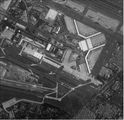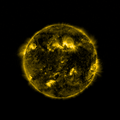PROBA 1/2 Downlink
The PROBA (Project for On-Board Autonomy) 1, 2 and V are advanced minisatellites that perform very different tasks on the same architecture.
Satellites[edit]
PROBA 1[edit]
This satellite is equipped with the following instruments:
- CHRIS (Compact High-Resolution Imaging Spectrometer) that can provide very high resolution (17 m/px) images of ground objects in 19 spectral bands.
- HRC (High Resolution Camera) provides higher resolution (8 m/px or greater) images of ground objects in a single band.
PROBA 2[edit]
This satellite is equipped with the following instruments:
- SWAP (Sun Watcher using Active Pixel) watches and images the Sun
- LYRA (Lyman-Alpha Radiometer) observes the total solar irradiance at a high refresh rate
- DSLP (Dual Segmented Langmuir Probe) measures the density of space plasma and its variations, together with TPMU (Thermal Plasma Measurement Unit)
PROBA V[edit]
This satellite is equipped with the following instruments:
- VEGETATION is a multiband imager tasked to image the world's forests.
Many other experimental/demonstration sensors are flown both on the PROBA, their list can be found in official pages for the satellites.
Signal[edit]
The signal is an S-Band BPSKBinary Phase-Shift Keying (1 bit per symbol) digital signal encoded using CCSDS standards, with a convolution rate of 1/2 and a bandwidth of 4 MHzMegaHertz (MHz) 10^6 Hz. The data rate is 1 Mbit/s, and the frequency is 2235 MHzMegaHertz (MHz) 10^6 Hz for all PROBA satellites.
Transmission schedule[edit]
All PROBA satellites dump their data to an ESA ground station in Redu, Belgium. The dumps are made very irregularly for PROBA 1 and V (only if the satellite has data to dump) and at the first useful afternoon orbit that is sufficiently above the ground station for PROBA 2, typically this means above 30°.
If there is no data to transmit, the satellite will transmit filler data. If there is no line of sight to the ground station, the satellite will not transmit at all (not even a carrier).
Additionally, Proba V is known to often image space only, or the Moon. Vegetation data is transmitted very rarely.



